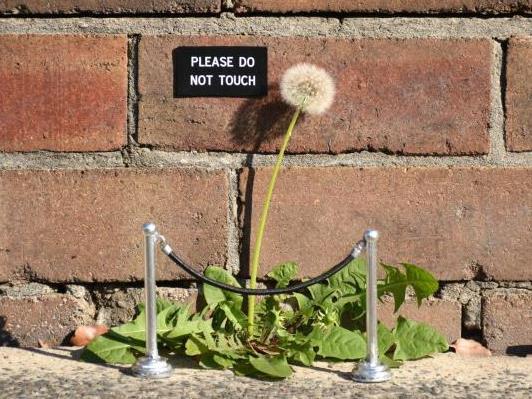Image: miguelmarquezoutside.com
With the median creative income for Australian artists being $7,000 – and $22,500 for those working on their practice full time – it’s no wonder the myth of the starving artist in a garret persists.
The contemporary equivalent can be a struggle to make rent, run a car or pay for dental care and a constant insecurity that affects relationships and well-being.
Head of the Academy at University of Western Sydney James Arvanitakis said the economic realities are very difficult for the vast majority of artists.
‘Life in Australia is expensive and our relatively small and dispersed population means that making a living very hard – let alone a comfortable living. This, combined with the need to balance the many roles an artist must take means that this can be a difficult existence,’ he said.
‘I do not want to make out as if every artist is struggling: far from it, but the reality is that this is a challenging environment and people need to be resilient,’ he added.
Read: How do your finances affect your arts practice?
Yet despite the challenge and difficulties ranging from funding cuts to devaluing of creative work, again and again artists prove their resilience and carve out fulfilling and self-sustaining careers. How do they do it?
During West Space’s panel discussion, The Trouble with Remuneration visual artist Janet Burchill said that when trying to make money out of art, she feels like a ‘spectacularly incompetent small business,’ but that it is possible to survive in the art world.
To explore these possibilities, we asked artists and arts workers to share their tips on navigating the economic realities of the arts industry.
Think of budgeting as part of your arts practice
Regional based photographer PollyannaR credits her sustainability as an artist to her resourcefulness and her willingness to regard financial sacrifices as part of the process of making art.
‘I believe my work as artist doesn’t start with photography. My art starts at five o’clock in the morning when I wake up to make sure I have breakfast so that I’m not going to get to work at nine and buy a coffee and a biscuit,’ she said. .
Her key advice for those seeking to survive as artists is: ‘Consume less – if you are serious about your art, consume less of everything. Consume less alcohol, consume less takeout food, consume less bought coffee, consume less clothes.’
Choose your lifestyle
Writer and arts administrator Marion Piper views the ability to get by on the smell on an oil rag as dependent on what kind of life you want to lead.
‘It’s possible to embrace the “starving artist” stereotype and be living below the poverty line, but making incredibly amazing work. The adverse is also true; you can work productively in a job you love – or hate – that’s in the arts industry – or not – and make incredibly amazing work,’ said Piper.
Pursing a day job does not always lead to economic security. As artist and writer Beth Rose Caird pointed out during the West Space panel, meaningful work available to artists can be just as precarious, and often requires difficult mental or physical labour.
‘Because there is no safety net and no universal basic income for artists, and arts funding can be fraught, I worked a succession of shitty jobs. I’ve waited tables, I’ve been a kitchen hand, I’ve worked stock in bars, I’ve bumped empty glasses, I’ve changed nappies, I’ve sorted, I’ve filed, I’ve been a receptionist, a fruit picker, I’ve worked seasons in shearing sheds,’ said Caird.
Resist making expensive art
During the first ten years of her practice, PollyannaR invested everything she had in developing The Big Picture series – the world’s largest photographs.
‘I’ve maxed out credit cards, worked two to three jobs at a time, borrowed money from friends and family, I’ve crowd-funded, I’ve used absolutely every resource of my availability to channel into getting the project off the ground.’
But having these ‘blinkers’ has meant that costly mistakes lowered her resilience. PollyannaR is now making the shift to secure the money prior to starting projects.
‘I’m not going to be so stressed and worried about how I’m going to pay for everything.’
‘I have to take my foot off the throttle until someone – whether it be the government, a foundation, or an organisation – values what I do.’
PollyannaR has found the decision to be more selective empowering. ‘All of a sudden I have a choice. Instead of thinking if don’t do this project I’m not going to be an artist, I’m not going to be successful, I’m not going to lift my profile – now I see that I can afford to wait six months until the right opportunity comes along.’
Piper agrees. ‘Stop paying for exhibitions out of your own pocket – crowd-fund it or fundraise that money, because you need a roof over your head and food in your belly in order to make that art in the first place.’
‘Get thrifty and exhibit your work in an alternative space for free – the possibilities are endless.’
Talk to each other
Discussing the economic realities of being an artist is integral to improving them, explained Caird.
‘The art world and the free market thrives on implanting fear in young artists that makes us believe there isn’t room for everyone to create art and share it with one another. This is untrue and deliberately alienating, and to resist this I sincerely try to care radically for and with fellow artists, writers and poets I know.’
Arvanitakis agrees that to survive, we must not only talk about sustainability but practice it. ‘Build networks of support to ensure that we take care of ourselves and others.
‘Never be scared to ask for help and learn those skills that ensure you can promote your work,’ he said.
Without these conversations and support networks, there is the risk income-stability determining one’s ability to become an artist.
‘We are so lucky to live in the time and place we do; privilege should not be downplayed, as it’s a spectrum, not solely a defining identity anymore. What I mean by this is that it’s possible to be broke and making art and comfortable and get by economically, all at the same time, and that this spectrum exists across the scope of a career,’ added Piper.
Regard self-care as an investment
Don’t underestimate the connection between self-care and economic sustainability.
The main thing you need to make art is a healthy body, said Piper.
‘Do something everyday that’s just for you,’ she suggested. Take care of yourself by doing work you enjoy, exercising regularly, eating well, resting, spending time in your home or in nature, limiting screen time, sleeping and maintaining decent relationships.
Read: 50 ways to take care of yourself
‘In Choose Yourself, James Altucher explains that when you are physically healthy, around the people you love, and when you exercise your idea muscle, and when you cultivate an ability to surrender to the reality around you, it frees you up so you can become an Idea Machine,’ said Piper.
Remember why you chose this lifestyle
It helps to remember that the difficulty artists face in their chosen lifestyles are just a different variety of difficulty from those they would face had the chosen a more financially rewarding but less satisfying career path.
‘It is difficult being an artist but so is being a medical doctor or lawyer or receptionist,’ said Piper.
‘I think it helps to keep the bigger picture in mind and to continually ask yourself the question: “What value am I adding to the world to make it a better place?’ she concluded.





